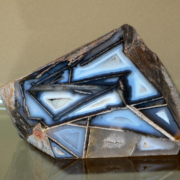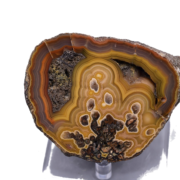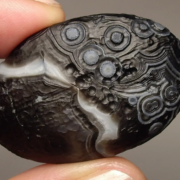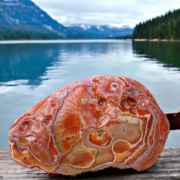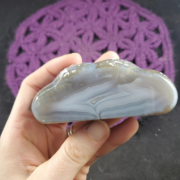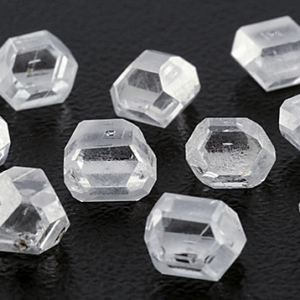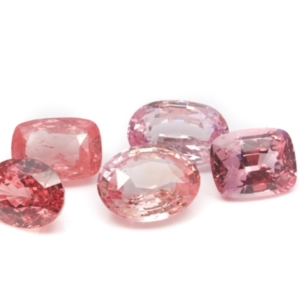Agate: Properties, Uses and Virtues
Agate: An enchanting gem with a rich history and spiritual aura
Agate, a captivating gem from the Chalcedony family, seduces with its bewitching patterns and vivid hues. Revered by gemologists and jewelry enthusiasts alike, agate’s micro-crystalline structure and translucent appearance exude an aura of elegance. Its unique banded pattern adds to its charm, making it a favorite choice for jewelry, decorative objects and spiritual practices.
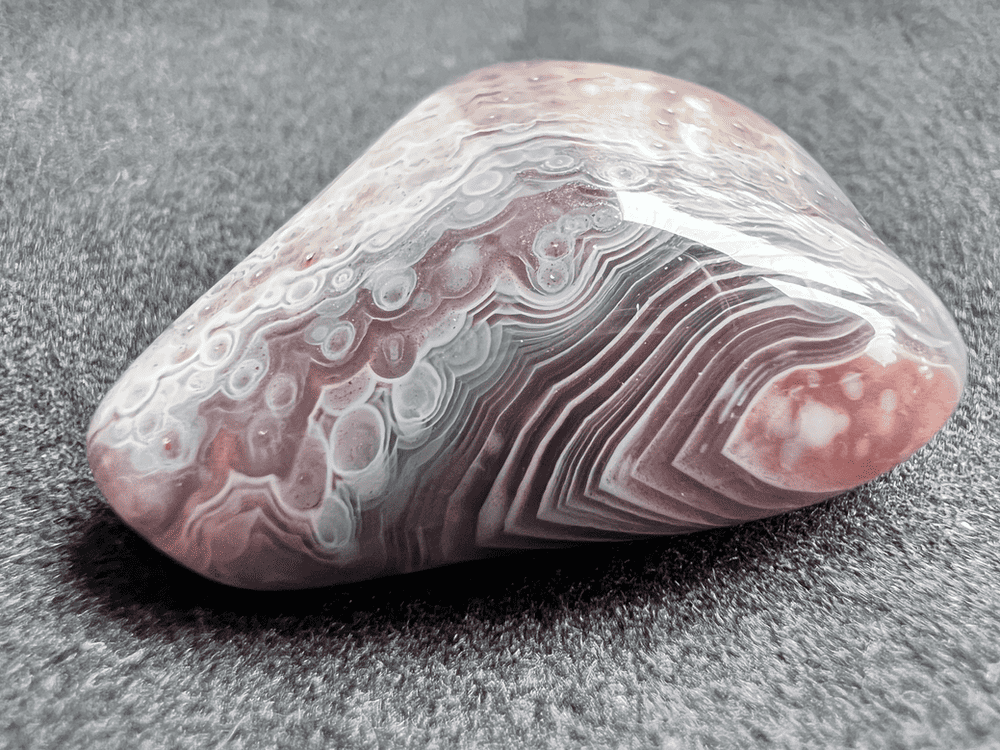
- Agate Geological Formation
- Rough Agate – Agate’s unique polycrystalline nature
- Sources – Exploring the worldwide origins of Agate
- Historical significance of Agate – A history of timeless fascination
- Metaphysical Properties of Agate – A journey into the spiritual realm of agate
- Agate varieties: A kaleidoscope of colors and patterns
- Agate Colors – Natural palette
- Durability and Wearability of Agate – A stone built to last
- Agate Treatments and Enhancements – Tincture
- Synthetic Agate – Nature in the Laboratory
- Imitations of Agate – Ensuring authenticity
- Agate Care – Preserving natural beauty
Agate Geological Formation
Agate, a variety of polycrystalline quartz, emerges in cavities or vesicles in igneous rocks, born of ancient volcanic activity. Escaping gases from the cooling magma create these cavities, providing an ideal environment for agate formation.
Over time, mineral-rich groundwater permeates these voids, depositing layers of silica and other minerals. The gradual accumulation of various minerals gives rise to the characteristic band patterns synonymous with agate. The stone’s distinctive colors and patterns are shaped by the unique mineral composition and impurities present during its formation.
Rough Agate – Agate’s unique polycrystalline nature
Unlike many gemstones, agate’s distinctive polycrystalline structure of microscopic crystals contributes to its bewitching appeal. As gemologists and collectors explore the world of agate, they are captivated by its natural patterns and colors.
Within each agate specimen, lace-like patterns, bands and dendritic inclusions form, creating individual masterpieces
Sources – Exploring the worldwide origins of Agate
Agate deposits are scattered around the world, with notable sources in Brazil, Uruguay, India, Madagascar, Australia and the USA. Each region contributes its own range of colors and patterns, adding to the appeal of this enchanting gem.
Historical significance of Agate – A history of timeless fascination
The history of agate goes back thousands of years, its name coming from the Achates River in Sicily, where it was first discovered by the ancient Greeks. Since ancient times, agate has been cherished for its beauty and protective qualities, finding its way into various forms of art, jewelry and objects among ancient civilizations. Healing and metaphysical properties have been attributed to the gem throughout history, adding to its mystery.
Metaphysical Properties of Agate – A journey into the spiritual realm of agate
Agate is considered a stone of balance and harmony, its gentle energy promoting emotional stability, grounding and inner peace. Each variety of agate is said to possess specific metaphysical properties.
For example, blue lace agate is linked to communication and self-expression, while moss agate reinforces the connection with nature. Many use agate in meditation to align mind, body and spirit.
Agate varieties: A kaleidoscope of colors and patterns
Agate offers a diverse range of bewitching colors and patterns. Notable varieties include :
- Blue lace agate: Celebrated for its soft sky-blue hues with delicate white bands, this gem exudes calm and serenity. Blue lace agate is thought to improve communication and clarity of thought.
- Crazy Lace Agate: True to its name, this stone features intricate swirling patterns and vibrant colors, evoking joy and invigorating energy. It is often used to promote flexibility and balance in life.
- Botswana Agate: Renowned for its soothing gray and brownish-pink bands, this gem promotes emotional stability and offers comfort in difficult times.
- Moss agate: Resembling a picturesque landscape with green inclusions reminiscent of moss, this stone attracts abundance and prosperity.
- Fire agate: With its flamboyant colors, this gem brings out passion, courage and creativity.
- Orbicular or ocean agate: In contrast to opaque orbicular or ocean jasper, orbicular or ocean agate is semi-transparent to translucent, with oceanic patterns reminiscent of foamy waves.
- Iris or iridescent agate: With a captivating play of colors similar to the iris of the eye, this variety of agate presents an astonishing display of spectral nuances that fascinates the observer.
Each variety of agate possesses its own unique energy, making them cherished stones for jewelry, healing practices and spiritual exploration.
Agate Colors – Natural palette
Agate’s color palette is exceptionally diverse, from vibrant reds, oranges and yellows to soothing blues, greens and purples. The distinctive banding patterns of each stone create mesmerizing effects, making each agate gem a unique masterpiece.
Durability and Wearability of Agate – A stone built to last
Agate has excellent durability, scoring 6.5 to 7 on the Mohs scale. Although relatively hard, agate can be subject to scratching by harder materials such as diamond and corundum. Proper care ensures agate’s longevity, making it ideal for a variety of jewelry settings, including rings, necklaces, earrings and bracelets.
Agate Treatments and Enhancements – Tincture
Agate is sometimes tinted to enhance its natural colors or obtain vivid hues. These treatments are generally stable and do not significantly alter the gem’s metaphysical properties.
Synthetic Agate – Nature in the Laboratory
Agate is a natural gem, and synthetic versions are rare. The gem’s unique band patterns and color variations are difficult to reproduce in the laboratory. Immitations are more common.
Imitations of Agate – Ensuring authenticity
Although agate itself is rarely imitated due to its natural abundance and random patterns, buyers should be wary of imitation materials or falsely presented stones on the market. It is common to find resin or plastic in immitations.
Buying from reputable sources guarantees the authenticity of agate gems.
Agate Care – Preserving natural beauty
To preserve the beauty and brilliance of agate gems, proper care is essential.
Avoid exposing agate to aggressive chemicals, extreme temperatures or sudden temperature changes.
Clean agate jewelry with a soft cloth and mild soap solution, avoiding ultrasonic cleaners or steam cleaning, which can damage the stone.
Store agate jewelry separately when not in use to avoid scratches and damage.
